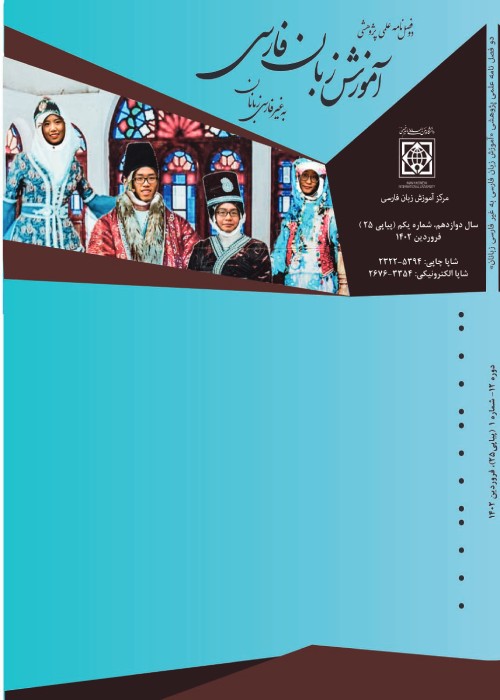Analyzing Rasa Teaching Persian to Non-Persian Speakers Video Series from a Social Semiotic Perspective
In the language teaching and learning context, with the increase in communicative language teaching theories worldwide, the use of video as an audio-visual material has proliferated (Bal-Gezegin, 2014). Nowadays, many publishers produce language learning videos tailored specifically for students in a foreign language program to accompany and complete textbooks. Videos are multimodal because they rely on various semiotic modes or sources (language, gesture, visual imagery, movement, color, music, sounds, and so on). Videos can act as powerful elements in creating learners' knowledge of the real world (Katchen, 2002, as cited BalGezegin, 2014). Despite the abundance of research on images (e.g., Elmiana, 2019; Roohani & Saeidfar, 2013, Tahririan & Sadri, 2013, to name but a few), research on other kinds of visual materials such as videos has received scant attention. Considering the possible effects of videos on constructing learners' views and their psychological effects on the mind of learners, this study aims to analyze the elements of the Rasa Persian teaching video series (hence, RPTVS) created for non-Iranian Persian language learners from a social semiotic perspective. Accordingly, the research questions which guided this study are (1) What is the function of visual aspects in RPTVS?, (2) In what way do the visual aspects of RPTVS support interaction between learners and represented participants? To answer the research questions, three Rasa videos were randomly selected and analyzed based on Kress and van Leeuwen's (2006) three-fold metafunction of visual grammar. The materials selected for analysis in this study were the language teaching videos which accompany the Rasa series, for teaching Persian to non-Persian speakers, authored by Shirmohammdi and published in Iran by Al-Mustafa International University in 2012. Al-Mustafa University, established to promote and advance Persian language-learning worldwide for nonPersian speakers, is an international academic, Islamic, and Howzawi Institute in Qom, Iran. RPTVS comes in soft copy featuring 21 units on the whole with each unit accompanying one or two videos related to the particular topic of that unit. It should be mentioned here that the Fundamental level has been chosen because examination of all the levels was beyond the scope of this study and more importantly, the Rasa series is just at the elementary level. The details of the qualitatively analyzed videos were described separately based on the components of visual grammar, namely representational, interactional, and compositional meanings. In response to the first research question, i.e., the function of visual aspects in RPTVS, the findings of the study showed that the visual elements of RPTVS had a naturalistic and humanistic trend. In other words, RPTVS represents the participants in familiar and factual ways. Moreover, all human characters were adults, which might show that the videos were designed for adult users. Regarding the settings and locations, RPTVS portrays common objects which were familiar to students/learners; however, the selection of objects and locations seem somewhat outdated and outstripped by the Iranian lifestyle at present. The represented objects (e.g., clock, Television sets, sofas, tables and many more) are portrayed in ways that could hardly associate with the current life-ways of the Iranian people. Therefore, RPTVS did not show any indications of recent technological improvements in current Iranian society. The findings were in line with Tahririan and Sadri's (2013) findings in which Iranian high school old textbooks used outdated portrayal of objects, overdramatized national identity with poor modality and used grayscale printing. In response to the second research question which was to investigate whether the visual aspects of RPTVS support interaction between learners and represented participants, the results indicate that in the videos of the RPTVS, the medium shot is used more frequently. In this fashion, it can be concluded that the language learners are supposed to keep a personal relationship with the participants as much as possible. The most common contact in videos is the gaze of represented participants toward each other, which shows that represented participants are communicating and encouraging the learners to communicate. Moreover, the results show all visual elements form a demand video through their gaze. In terms of contextualization, the study showed that all videos contained background, except few scenes with a blank background. However, the videos represented real-life activities, which is in line with Ahmadi et al.’s (2020) study of Persian learning textbooks in which the images contained real-life activities to introduce Iranian social life at the national level. Thus, the analysis of the videos based on contextualization modality indicates that theyrepresent authentic meaning in real-life settings. The results of this study suggest that locally developed materials for language teaching, be it teaching English to Iranian learners or Persian to international students, share a lot of similarities in transmitting language and cultural norms to learners, which distinguish it from international publications such as Touchstone or Interchange series. Specifically, Iranian locally developed materials display substantial commonality in terms of culture load. The major implication of this finding is that to enhance the efficacy of the content, instructors need to raise international learners' cognizance of the intricacies, customs, traditions, and values in the Persian culture which make it unique and different in its own right.
- حق عضویت دریافتی صرف حمایت از نشریات عضو و نگهداری، تکمیل و توسعه مگیران میشود.
- پرداخت حق اشتراک و دانلود مقالات اجازه بازنشر آن در سایر رسانههای چاپی و دیجیتال را به کاربر نمیدهد.



